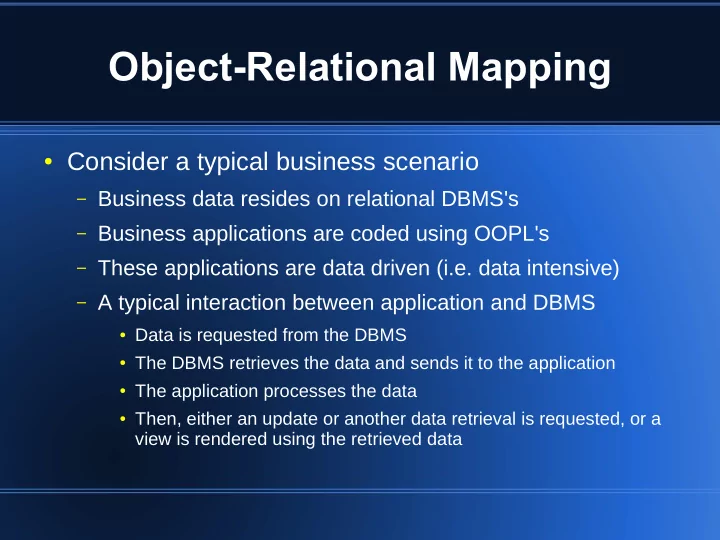

Object-Relational Mapping ● Consider a typical business scenario – Business data resides on relational DBMS's – Business applications are coded using OOPL's – These applications are data driven (i.e. data intensive) – A typical interaction between application and DBMS ● Data is requested from the DBMS ● The DBMS retrieves the data and sends it to the application ● The application processes the data ● Then, either an update or another data retrieval is requested, or a view is rendered using the retrieved data
Object-Relational Mapping ● Details of the interaction – Data request (application) ● Uses an API to send SQL strings to the DBMS ● API: DBMS specific (e.g., libpq.so) or agnostic (e.g., JDBC) – Data retrieval (DBMS and application) ● The DBMS sends data back to the application ● The application uses the API to process the returned data – Updates (DBMS and application) ● The application uses the API to send SQL strings to the DBMS ● The DBMS executes the updates and returns status and/or data ● The application uses the API to check the result of the update
Object-Relational Mapping ● Object-Relational Impedance Mismatch – Design goals (data vs behavior) – Building blocks (tables/rows/fields vs classes/instances) – Type systems (e.g. BLOB vs PDFDocument) – Data retrieval (query based vs navigational access) – Data modification (DML vs setters) – Error handling (no recovery vs structured error handling) – Other ● DBMS: referential integrity, transactions, concurrency control, etc ● OOPL: inheritance, interfaces, relationships, reflection, etc
Object-Relational Model ● What is the optimal solution? – A single data model across PL and DBMS ● What is does a sub-optimal solution look like? – Bring the PL and DBMS data models as close as possible – Make this procedure as automatic as possible – Effectively isolate all this plumbing from the business layer – Allow freedom for choice (PL and DBMS)
Object-Relational Mapping ● ORM as one solution (not “the” solution) – Natural programming model ● You program OOP, the mapping layer does the data plumbing – Classes can be used and tested independently of application – Minimize DBMS trips with optimized fetching strategies ● A good tool is expected to do better than average programmers – Coding ● Reduced coding time and total code size ● Code is easier to read and maintain – Error frequency is significantly decreased
Object-Relational Mapping ● ORM Desirable Features (not exhaustive) – Transparency (POJOs/Beans) – Transitivity (relationships) – Persistent/transient instances (attached/detached) – Automatic dirty instance detection – Inheritance strategies (single table, class per table, etc) – Fetching strategies (lazy/eager) – Transaction control – Flexible, “sensible defaults” based configuration – Availability of development tools and learning resources
Object-Relational Mapping ● Other solutions – Native OODBMS's ● db4o is a Java/.NET open source OODBMS (go check it out!) ● Ozone is a Java open source OODBMS (older but advanced) – MS LINQ ● LINQ stands for Language Integrated Query – Persistent Programming Language ● No discrete boundary between program and database objects – Others...
Object-Relational Mapping ● Further reading – There are good books on the subject and a number of (very) decent resources online – Ireland, C. et al. A Classification of Object-Relational Impedance Mismatch. DBKDA'09. (download if from IEEE Xplore, accessible via the UB Libraries subscription) – Minnaar, Douglas. Object-Relational Mapping as a Persistence Strategy. http://tinyurl.com/yeao2fq.
Recommend
More recommend